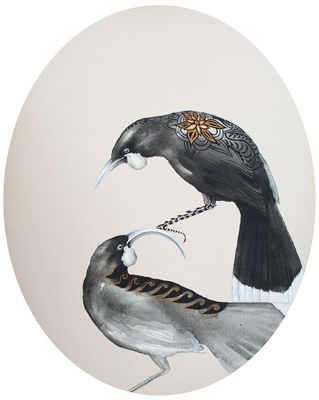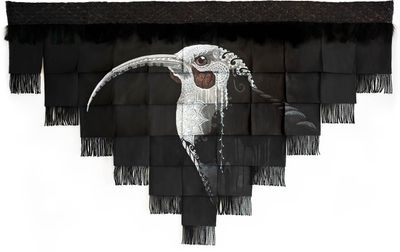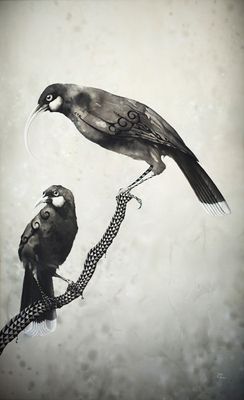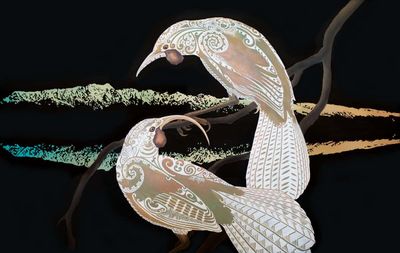
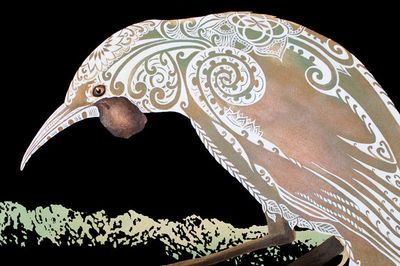
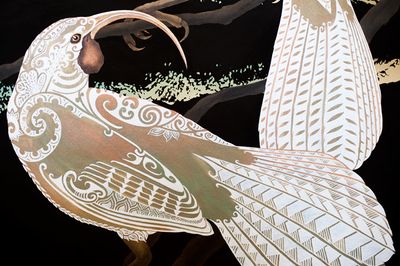
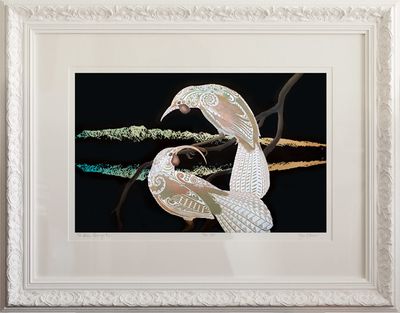

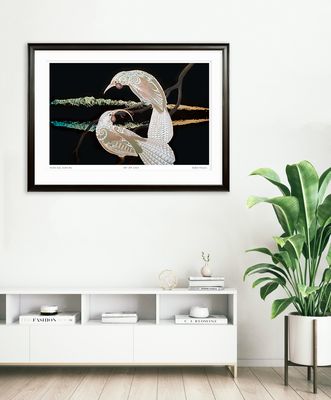
Aroha mai, aroha atu
$2,500.00
Explore the story of the artwork >>
Print sizes and editions
- Regular museum archival paper print - 820 x 520mm
(limited to 75) - Large museum archival paper print - 1137 x 721mm
(limited to 75) - Extra Large museum canvas print - 1277 x 810mm
(limited to 75)
Your unique limited edition fine art print
- Sofia Minson creates your exclusive signed print
- We ship for $25 in NZ and from $50 internationally
- Your artwork arrives rolled, ready to be framed - do you need help? Request framing guidance
Original painting SOLD, Acrylic on canvas with black wooden ornate frame, 1640 x 1090mm, 2015
The story of Aroha mai, aroha atu
The meaning behind this piece is so poignant for the years since 2020. It is entitled "Aroha mai, aroha atu" after the ancient Māori proverb meaning "Love received, love returned" and depicts two huia birds.
'Aro' means to focus and 'hā' is our breath of life, therefore 'aroha' means to focus our essence or lifeforce energy on something or someone.
In the last few years as we experience the old culture and way of life disappearing, Sofia believes it is making way for an upwelling of brand new ways of living and creating with the earth and each other. "Aroha mai, aroha atu" is about embodying the energies of gifting and receiving - the higher harmonics of giving and taking.
Many are choosing to move into this abundant frequency and letting go of the desperateness of ownership; the withholding of energy; the judgement of right and wrong and the lack mentality that comes from feelings of painful isolation. As Charles Eisenstein would say, "let's create a more beautiful world our hearts know is possible."
Balance and symmetry
The play of forms and use of black and white tones in this painting explore polar opposites - positive and negative, darkness and light, female and male, yin and yang. The spectrum of these dual forces are present in all things and are balancing each other out all the time, whether or not it is perceived this way.
The two sides of love
Two extinct native huia birds perch on branches in the foreground showing how dramatically different the bill sizes and shapes were between female and male. Huia exhibited the most extreme sexual bill dimorphism of any bird species in the world and were said to have mated for life.
The Remarkables - Queenstown's distinct mountain range is reflected perfectly in Lake Wakatipu in the background. Although huia were a North Island bird, since their extinction they have occupied the imagination of the whole of New Zealand and in this South Island landscape, stake their claim as a universal emblem of Aotearoa, of ancestral connection, and of the two sides of love.
Sofia's technique and process
The technique Sofia used on this painting was to first layer the canvas with smoothly blended metallic gold, blue and copper acrylics and then map out in minute detail using black ink-like paint, the mountain range and its reflection in the lake. The huia were lastly painted as intricate Māori designs with a hint of Hindu mandala influence, in iridescent pearl white paint. The iridescent and metallic paint reflects the light and changes in mood depending on the angle of the light in the room, while the black in the painting absorbs the light and is deep, matte and unchanging.
Uia, uia, uia (where are you?)
Huia were striking large songbirds, mainly black with long white-tipped tail feathers. A fleshy orange wattle hung at the base of each side of the bill. Māori named the bird after its loud distress call, described as "a smooth, unslurred whistle rendered as uia, uia, uia or where are you?" The last accepted sighting was in 1907, but it is likely that a few huia persisted into the 1920s.
Sofia Minson Paintings | New Zealand Artwork

